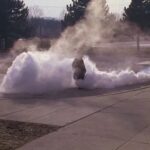Swapping a JDM B18b engine into a vehicle originally equipped with a D16Y7 engine, particularly models within the Honda Civic EK series, is a popular upgrade. However, this process often brings wiring harness compatibility challenges. This guide addresses the discrepancies between the JDM B18b and D16Y7 ECU connectors, providing a clear pathway to adapt your existing D16Y7 wiring harness for a seamless B18b engine integration. This article focuses on practical solutions, ensuring your engine swap is electrically sound and efficient.
Oxygen Sensor Considerations
One of the primary differences lies in the oxygen sensor setup. The D16Y7 engine utilizes both primary and secondary heated oxygen sensors, with the secondary sensor positioned after the catalytic converter. In contrast, the JDM B18b engine management system is designed to operate effectively with only a primary heated oxygen sensor located before the catalytic converter.
For those obligated to maintain a catalytic converter for emission compliance, like in regions with vehicle inspections, the solution is straightforward. You can retain your catalytic converter and simply ensure the primary oxygen sensor is functional. The secondary oxygen sensor, along with its associated wiring, becomes redundant for the B18b engine.
The Fix: Disconnect the secondary heated oxygen sensor connector from the D16Y7 harness. At the ECU connectors, specifically remove wires from pins A5, D13, and D14, which are associated with the secondary heated oxygen sensor.
Impact: This modification has no adverse effects on the B18b engine’s performance or the overall operation of your EK chassis vehicle. The B18b ECU is not programmed to expect or utilize data from a secondary oxygen sensor.
Idle Air Control Valve (IACV) Adjustment
Another key wiring difference arises with the Idle Air Control Valve (IACV). The JDM B18b engine is equipped with a two-wire IACV system, while the D16Y7 engine uses a three-wire IACV. Adapting to this requires a minor adjustment within the ECU connector wiring.
The Fix: Locate wire A14 at the D16Y7 ECU connector, and move it to position A12. Subsequently, disconnect and cap wire A13 at the ECU connector, as this wire is not needed for the two-wire IACV configuration of the B18b.
Impact: This adjustment ensures the correct IACV signal is sent to the B18b ECU, maintaining proper idle control without impacting engine performance or vehicle operation.
Crankshaft Speed Fluctuation Sensor Compatibility
The JDM B18b engine management system does not require a Crankshaft Speed Fluctuation Sensor, which is part of the D16Y7 sensor suite. This sensor typically feeds into ECU connectors C1 and C11 on the D16Y7 setup.
The Fix: Leave the Crankshaft Speed Fluctuation Sensor harness connector from the D16Y7 harness disconnected. At the ECU connectors, remove wires from positions C1 and C11, as these are no longer necessary for the B18b engine.
Impact: Eliminating the Crankshaft Speed Fluctuation Sensor wiring has no negative consequences for the B18b engine or the vehicle’s functionality. The B18b ECU simply does not utilize this input.
Evaporative Emission Purge Control Solenoid Valve
The Evaporative Emission Purge Control Solenoid Valve, present in the D16Y7 setup and connected to ECU pin A15, is another component not directly required by the JDM B18b engine for basic operation. While EK chassis vehicles are equipped with an evaporative emission purge control system, the JDM B18b ECU may not fully utilize or monitor this system in the same way.
The Fix: Disconnect the Evaporative Emission Purge Control Solenoid Valve harness connector from the D16Y7 harness. Remove wire A15 from the ECU connector.
Impact: For basic B18b engine operation, this disconnection will not cause immediate issues. However, the long-term impact on the EK’s evaporative emission system and potential environmental consequences should be considered, especially in regions with emission regulations. Further research into maintaining evaporative emission control with the B18b ECU in an EK chassis is advisable for a fully compliant and environmentally conscious swap. It is important to understand the implications of removing this system, particularly concerning emissions and potential fault codes, depending on local regulations and personal preferences.
Power Steering Pressure Switch Integration
The JDM B18b wiring is configured to accommodate a Power Steering Pressure Switch (pin C16 at the ECU). However, if your EK chassis vehicle, like many base models, does not have power steering, this connection becomes irrelevant.
The Situation: If your EK does not have power steering, no action is needed regarding the Power Steering Pressure Switch wiring.
Impact: The absence of a signal from the Power Steering Pressure Switch (C16) will have no operational impact on the JDM B18b engine or the EK vehicle if power steering is not equipped. The B18b ECU is designed to function normally whether or not this signal is present, indicating a failsafe design for vehicles without power steering.
Conclusion
Adapting a D16Y7 wiring harness for a JDM B18b engine swap is a manageable process through these targeted modifications. By addressing the oxygen sensor setup, IACV wiring, Crankshaft Speed Fluctuation Sensor, Evaporative Emission Purge Control Solenoid Valve, and Power Steering Pressure Switch considerations, you can effectively integrate the B18b engine into your EK chassis. While some modifications, like disconnecting the Evaporative Emission Purge Control system, require further consideration for long-term emissions compliance, the core engine functions will operate correctly with these adjustments. This guide provides a solid foundation for a successful and electrically sound B18b engine swap using your existing OBD2 wiring harness.
